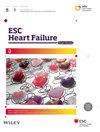Impact of mitral valve transcatheter edge-to-edge repair on haemodynamic parameters in cardiogenic shock
Abstract
Background
Transcatheter edge-to-edge repair (TEER) has been shown to be an effective treatment option for patients experiencing cardiogenic shock (CS) with concomitant high-grade mitral valve regurgitation. However, haemodynamic changes following M-TEER have not been thoroughly investigated. Afterload mismatch, leading to the deterioration of haemodynamics subsequent to mitral regurgitation correction, could potentially occur and adversely impact prognosis. Our objective was to analyse the effect of TEER on haemodynamic and echocardiographic parameters in patients with CS.
Methods and results
We conducted a retrospective study of patients undergoing TEER for mitral valve regurgitation in the setting of CS. Haemodynamic and echocardiographic parameters before and after TEER were systematically analysed. A total of 25 patients underwent TEER in the context of CS. All patients were successfully treated with at least of one grade reduction in mitral regurgitation. The median left atrial mean pressure decreased from 23 mmHg (IQR 17–30) to 16 mmHg (IQR 11–20, P < 0.01), and the V-wave decreased from 36 mmHg (IQR 27–44) to 21 mmHg (IQR 14–25, P < 0.01) following the procedure. The stroke volume index and cardiac index increased from 25 mL/m2 (IQR 18–29) to 34 mL/m2 (IQR 25–44, P < 0.01) and from 1.90 L/min/m2 (IQR 1.41–2.30) to 2.50 L/min/m2 (IQR 1.99–2.86, P < 0.01), respectively. We did not observe any worsening of the ejection fraction after the procedure. Ten patients (40%) died during their hospital stay.
Conclusions
Our study demonstrates that TEER leads to favourable haemodynamic changes in patients with CS. We observed a significant reduction in left atrial pressure, V-wave, and an elevation in cardiac index. Importantly, we did not observe any deterioration in left ventricular function following the procedure. This supports the concept of haemodynamic stabilization with TEER in patients with CS and high-grade mitral regurgitation.


 求助内容:
求助内容: 应助结果提醒方式:
应助结果提醒方式:


